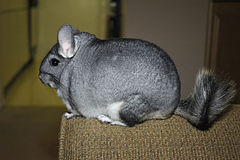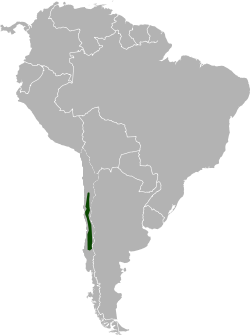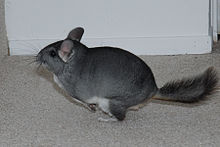- Long-tailed chinchilla
-
Long-tailed chinchilla 
Conservation status Scientific classification Kingdom: Animalia Phylum: Chordata Class: Mammalia Order: Rodentia Family: Chinchillidae Genus: Chinchilla Species: C. lanigera Binomial name Chinchilla lanigera
Bennett, 1829
Past range of Chinchilla lanigera. Synonyms Mus laniger
Chinchilla velligera
Cricetus chinchilla
Lommus lanigera
Cricetus lanigeraThe long-tailed chinchilla (Chinchilla lanigera), also called the Chilean, coastal, common chinchilla, or lesser chinchilla, is one of two species of rodents from the genus Chinchilla, the other species being Chinchilla chinchilla. Wild populations of C. lanigera occur in Aucó, near Illapel, IV Región, Chile (31°38’S, 71°06’W), in Reserva Nacional Las Chinchillas and in La Higuera, ca. 100 km (62 mi) north of Coquimbo (29°33’S, 71°04’W)[2] Chilean chinchillas were reported from Talca (35°30’S), Chile, reaching north to Peru[3] and eastward from Chilean coastal hills throughout low mountains. By the mid-19th century, Chilean chinchillas were not found south of the Choapa river.
No fossils are known.
Contents
Characteristics
Chinchilla lanigera is smaller than Chinchilla brevicaudata, wild animals have body length up to 260 mm (10 in). It has more rounded ears 45 mm (1.8 in) in length and longer tail its tail is usually about a third the size of its body (up to 130 mm (5.1 in) compared to 100 mm (3.9 in) in Chinchilla brevicaudata). Number of caudal vertebrae is 23 in Chinchilla lanigera (20 in Chinchilla brevicaudata). Average males weight 369–493 g (13.0–17.4 oz) (mean: 412 g (14.5 oz)) and females weigh 379–450 g (13.4–16 oz) (mean: 422 g (14.9 oz)).[4] Domestic animals are larger than wild ones and more sexually dimorphic with the female weighing up to 800 g (28 oz) and males up to 600 g (21 oz).
The word lanigera translates into "bearing a woolen coat", yet chinchillas do not have a woolen coat, but instead one consisting of hair. Hair is 2–4 cm (0.79–1.6 in) long, with gray, white, and black bands; it is silky, extremely soft, and firmly adhered to skin.[3] Up to 75 wool hairs, 5–11 mm (0.20–0.43 in) in diameter, emerge together from a single skin pore. Vibrissae are abundant, strong, long (100–130 mm (3.9–5.1 in)), and emerge from single follicles.[5] General color of upper parts is bluish or silvery gray, underparts are yellowish white. Tail has long, coarse, gray and black hairs on its dorsal surface that are 30–40 mm (1.2–1.6 in) long near the body, 50–60 mm (2.0–2.4 in) long near the tip, and form a bristly tuft that exceeds vertebrae by 50 mm (2.0 in)[3]
In the wild they breed between October and December, which are the summer months in the southern hemisphere.[4]
Varieties
Three different types of C. lanigera are commonly recognized[6]
- The La Plata Type has better developed musculature and heavier bone structure than the other two types. They look more roundish or compact, with short, wide head, large distance from one ear to another, a relatively straight dorsal line. The shoulders are often as wide as the chest and rump. The ears are short and nearly round.
- The Costina Type is weaker in musculature and bone structure with the most distinctive feature being the longer hind legs. The fore legs are shorter, placed closer together, and the shoulders are narrower. The vertebral column is more arched, the neck line sometimes very deep, forming a slight hump on the back of the animal. When viewed directly from the front, the head has a V-shape, the nose is pointed, and the distance between the ears is rather wide. The ears are long and positioned at an angle of about 45 degrees.
- The Raton Type is reminiscent to the La Plata type in its body structure. The nose is pointed as in Costina and the ears are positioned very close together and rather horizontal. Animals are distinctively smaller.
Ecology
Climate in the chinchilla's habitat is rather harsh with summer temperatures climbing during the day to up to 30 °C in a shade and dropping to 7 °C at night (or below freezing point in winter).[4]
Pelt industry
See Fur industry
Conservation status
The Chilean chinchilla is endangered, with the second highest conservation priority among Chilean mammals.[7]
References
- ^ D'elia, G. & Teta, P. (2008). Chinchilla lanigera. In: IUCN 2008. IUCN Red List of Threatened Species. Downloaded on 5 January 2009.
- ^ Jiménez, J.E. (1996), "The extirpation and current status of wild chinchillas (Chinchilla lanigera and C. brevicaudata)", Biological Conservation 77: 1–6, doi:10.1016/0006-3207(95)00116-6
- ^ a b c Bennett, E.T. (1835). "On the Chinchillidae, a family of herbivorous Rodentia, and on a new genus referrible [sic] to it". Transactions of the Zoological Society of London 1: 35–64.
- ^ a b c Spotorno, Angel E.; Zuleta, C.A., Valladares, J.P., Deane, A.L., and Jiménez, J.E. (15 December 2004). "Chinchilla laniger". Mammalian Species 758: 1–9. doi:10.1644/758. PDF
- ^ Wilcox, H. N. (1950). "Histology of the skin and hair of the adult chinchilla". Anatomical Record 108: 385–397. doi:10.1002/ar.1091080304. PMID 14799877.
- ^ Bickel, Edmund (1987), Chinchilla Handbook, Neptune City, NJ: T.F.H. Publications, Inc., ISBN 0-86622-494-7.
- ^ Cofré & Marquet, P.A. (1999), "Conservation status, rarity, and geographic priorities for conservation of Chilean mammals: an assessment.", Biological Conservation 88: 53–68, doi:10.1016/S0006-3207(98)00090-1
Kingdom: Animalia · Phylum: Chordata · Class: Mammalia · Order: Rodentia · Suborder: Hystricomorpha · Infraorder: Hystricognathi · Parvorder: CaviomorphaChinchilla Lagidium
(Mountain viscachas)Lagostomus Categories:- IUCN Red List critically endangered species
- Chinchillidae
- Mammals of Chile
- Mammals of the Andes
- Domesticated animals
- Pet rodents
- Animals described in 1829
Wikimedia Foundation. 2010.


